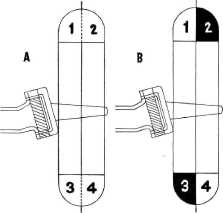1942 - 1947 CHEVROLET SHOP MANUAL
Section 10 - Wheels & Tires
|
|
|||
|
10-4
|
|||
|
|
|||
|
useful life of his tires by taking the turns a little
slower or a little wider. The
tires and wheels should be
interchanged in accordance with instructions
given under the heading "Correction of
Irregular Tire Wear."
No changes can be made to the car or tires to
improve cornering wear, and it is
advisable to check
alignment only if abnormal camber wear is
encountered and changes should
only be made when the
camber is found to be beyond factory
specifications.
TIRE BALANCE
Original equipment tires and tubes are marked
at source, so that the light
portion of the casing is
counterbalanced by the heavy portion of the tube.
Due to irregularities in tread wear, caused by
sudden brake applications,
misalignment, low inflation
pressure, or tube and casing repairs, a casing
and tube assembly can lose its original balance.
If a disturbance is felt in the steering wheel
due to the action of the front
wheels, the first items to
check are pressures and the balance of the
tire and wheel assembly.
BALANCING WHEELS AND TIRES
Wheel balance is the equal distribution of the
weight of the wheel and tire
assembly around the axis of
rotation. There are two ways in which
every wheel must be
balanced-statically and
dynamically.
STATIC BALANCE
Static balance (sometimes called still balance)
is the equal distribution of the
weight of the wheel and
tire assembly about the axis of rotation
in such a manner that the assembly has no
tendency to rotate by itself,
regardless of its position.
For example: A wheel with a chunk of dirt on the rim will
always rotate by itself until the
heavy side is at the bottom. Any wheel with a
heavy side like this is
statically out of balance.
Static unbalance of a wheel
causes a hopping or
pounding action (up and down) which frequently
leads to wheel flutter" and quite
often to wheel "tramp."
DYNAMIC BALANCE
Dynamic balance (sometimes called running balance) means that the
wheel must be in static balance
and also run smoothly at all speeds on an
axis which runs through the
center line of the wheel and tire, and is perpendicular to the axis
of rotation. To explain the
principle of dynamic
balance, let us first consider what happens when
we swing a weight attached to a
string. If we start to
swing this weight slowly, it is apparent that the
weight swings in a sharp angle
with reference to
|
the axis of rotation (the hand). If the speed is
increased, the weight climbs
until the weight mass is at right angles to the axis of
rotation. Now, let us apply this
principle to a spinning wheel.
|
||
 |
|||
|
Fig. 9-Wheel in Static Balance
By referring to Fig. 9-A, it can be seen that
when a wheel and tire assembly is
in static balance, the sum
of the weights of sections 1 and 2 is
equal to the sum of the weights
of sections 3 and 4; or,
in other words, the weight is equally distributed
about the axis of rotation. Fig. 9-B is a
drawing of a wheel that is in
static balance because
the shaded heavy point 2 is balanced by the shaded heavy point
3. However, it can be seen that
with reference to the center line, section 1 is lighter than section
2, and that section 4 is lighter
than section 3.
When we start to spin this wheel (as in Fig.
10-A) the center line of the
weight masses 2 and 3
tries to get at right angles to
the axis of rotation, just
as the weight on the string tried to get at right angles to its axis
of rotation (the hand).
This tendency to get at right angles exerts a force
on the wheel (as shown by the
arrows). This force, in
turn, tends to move the center line of the
wheel, and, in so doing, distorts
the axis of rotation.
When the wheel has turned 180°, the forces
exerted by the heavy sections 2
and 3 now tend to move the
center line of the wheel in the opposite
direction. In other words, the
wheel tries to rock first
in one direction, then in the other.
The result of the movement of these unbalanced
forces causes the wheel to wobble or shimmy,
and the condition becomes more
violent with increased speeds.
|
|||
|
|
|||